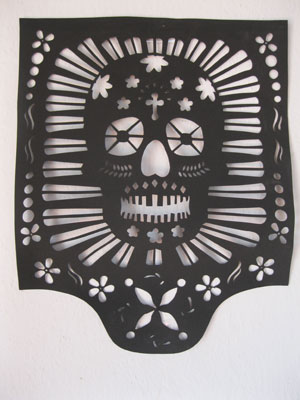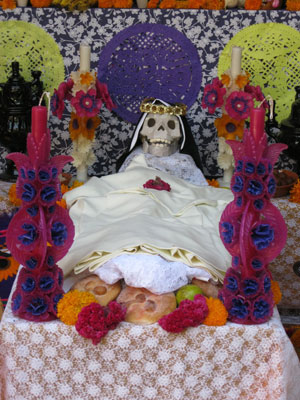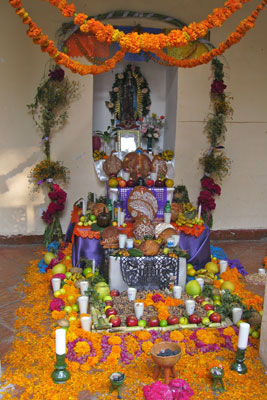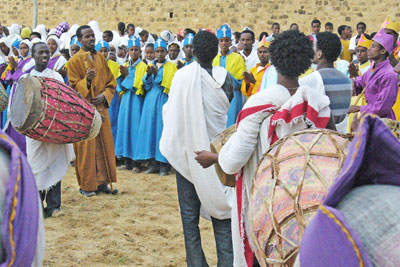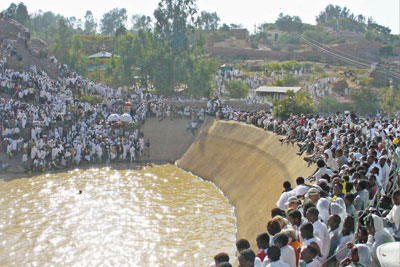Annual Themed Festivals (2 of 3)
We asked you to tell us about a fun, impressive or unique annual festival, celebrating something in particular, that you attended outside of the US in the last few years. We requested the name of the festival, where it takes place, when it takes place and for how many days plus the year you went. We also wanted to know what activities occurred, what you experienced, approximate costs, tips on how to get to the festival and any other helpful advice.
Last month, we printed descriptions of festivals in Asia. In this second of three parts, the responses are about festivals in LATIN AMERICA (Mexico, basically), the CARIBBEAN (Bahamas) and AFRICA (Ethiopia). If you are an ITN subscriber and have an event to share, write to Annual Themed Festivals, c/o ITN, 2116 28th St., Sacramento, CA 95818, or email editor@intltravelnews.com. Include the address at which you receive ITN. Photos are welcome.
The Day of the Dead has fascinated my daughter, Cate, and me for many years.
Mexicans are not sad on the Day of the Dead; they are happy. During the last two days of this special 3-day festival, which starts late on Oct. 31, families believe that their dead relatives and friends are going to visit them in spirit. They each make offerings for the dead visitors on an altar in their home and also clean and decorate the graves of their relatives.
The festival activities include parades, church events and some “trick or treating,” though the children say “Feed the skull!” instead.
2014 was our year to take the trip to MEXICO. Cate’s daughter, Frances, joined us, so we had three generations of women traveling together.
We knew the festivities would take place all over the country, but we were careful to pick out an area that was not so popular that we would get lost in the crowds nor so small that it would not have enough interests.
Because some of the cheapest tickets were to Mexico City (México, D.F.), we chose that as our airport destination, stayed the night in an airport hotel, then from Terminal 2 took an easy, 1½-hour bus trip (departs every 40 minutes) to Cuernavaca, a city of 300,000 in the south-central state of Morelos.
Almost no English was spoken in Cuernavaca. My granddaughter did all the translating for us. We saw very few tourists.
Desk staff at our hotel helped us catch cabs and gave us hints on Day of the Dead sights and activities to take in. A hotel employee accompanied us to the market on the day before the holiday, and we got to watch locals purchasing marigolds and other items for the altars they were setting up in their homes. It reminded us of a Christmas rush at home.
The Mexicans have special bread at this time called pan de muerte (bread of the dead). In this area, it was a round loaf with red-colored sugar. Bumps on the crust were in the form of crossbones.
On many of the altars in homes, people would place large photos of family members who had died. They also would leave flower blossoms in different patterns, and flower petals were arranged to look like the outlines of graves. Traditionally, a representation of a skull is placed in the center. The dead person’s favorite food may be set there as well.
From Cuernavaca we visited two graveyards.
The small town of Ocotepec was recommended for its large, old cemetery. The church bells in Ocotepec rang continuously the night of Nov. 1 to announce the official Day of the Dead coming up on Nov. 2.
We watched locals come to decorate graves with flowers, candles, crosses and tiny chapels with lit candles inside. Always, huge amounts of gold-colored marigold blossoms were lined up perfectly around the big tombstones, with petals strewn around. In the churchyard that night, there were displays of life-sized skeletons dressed in different outfits.
We could hear the sounds of men singing and playing guitars echoing in the graveyard. One song was about how we will not be able to take anything with us when we die.
Yes, we got in touch with our own mortality, but, rather than being sad, it was sort of cheerful.
We also took a 40-minute bus ride to Tepoztlán for a day. During the festival, locals walked among many stalls and offered a candle when invited into a private home to view the offerings set up inside for the recently deceased. They just followed the path of marigold petals to the doorstep.
A commonly sold item was a skeleton dressed in a fancy gown and wearing a huge, elaborately decorated hat. This was “Catrina.” The story goes that even though she was very rich, she, too, ended up a skeleton, no different than any poor Mexican woman. Catrina dolls were sold in many sizes all over the markets, and some ladies on the street were dressed like Catrina.
We will remember the respect and care shown to departed souls by the people of Mexico. Dedicating time to the memories, habits and preferences of our friends and family members who have passed on — leaving them offerings of flowers, food and music — is a beautiful custom.
Marilyn Maloney
Minnetonka, MN
Before I developed sensitivity to being at elevations over 5,000 feet a few years ago, I used to frequent the delightful city of Oaxaca in the state of Oaxaca in southwestern MEXICO. One of the happiest occasions there is the Guelaguetza, which is a dance festival celebrating the indigenous cultures of the region.
In a lovely amphitheater, performances began about 10 a.m. on the last two Mondays in July and lasted until sundown. Thousands of performers assumed the stage in the most colorful costumes imaginable, with colorful props, happy faces and wonderful music.
The performers threw everything from candies to flowers to whole pineapples into the audience, which added to the excitement.
I last visited there in 2004 or 2005. There was bus transportation to the vicinity of the amphitheater, then it was quite a hike to the entrance of the festival. It was well worth it, though. At that time, admission cost the equivalent of about $10.
Oaxaca has so much of interest besides this festival. One could easily spend at least a week visiting Zapotec and Mixtec ruins and nearby craft villages, plus there are marvelous restaurants, etc.
• Dias de los Muertos (Days of the Dead) are observed throughout Latin America, though I experienced them only in Mexico, between Oct. 31 and Nov. 2 each year. Mostly, my experiences were in Oaxaca, on at least four occasions between 1990 and 2004.
In Oaxaca, there were pilgrimages to nearby cemeteries on the night of Nov. 1, when the locals welcomed the deceased children back to Earth. On the night of Nov. 2 they welcomed the departed adults back to Earth.
The relatives of these folks built altars with colorful ofrendas, or offerings, containing the departed souls’ favorite foods, drinks, cigarettes, flowers, etc., and played music, all to make them feel welcome when they temporarily returned.
They would spend the entire night in the cemeteries playing their guitars or boom boxes, singing and gossiping with each other. Fair amounts of tequila and mescal were consumed, too.
The traditional Days of the Dead flowers are yellow marigolds and deep-red cockscomb. Skulls made of spun sugar and other candies are popular decorations, as are loaves of “dead bread,” also decorated with skulls.
Some folks look upon these celebrations as morbid, but they really aren’t.
Tracy Ferguson, Houston TX
Junkanoo festivals are held annually throughout the Caribbean. They are believed to date back to the 16th and 17th centuries and perhaps have their roots in West Africa. During those slave days, slaves were given holiday time to leave the plantations to meet with family and celebrate.
I attended the Junkanoo in Nassau, BAHAMAS, in 2009. I was staying at the British Colonial Hilton (One Bay St., Nassau; phone +1 242 322 3301, www.bchiltonnassauhotel.com), and the festival began on Dec. 26 at 2 a.m. (yes, a.m.) as parade units lined up near the hotel.
There were elaborate costumes plus music and dancing during the parade through downtown Nassau.
Bleacher seats were available; the hotel concierge picked them up for us. Parade seats cost less than $30. If you don’t want to get a reserved seat, I suggest going to the area between the Hilton and the parade starting point, where you can see the floats, costumes, etc.
The parade goes on into the morning, reportedly as late as 10 a.m. I stayed until only about 5 a.m., and it was winding down somewhat.
The parade changes every year, as the “clubs” pick a theme and work all year to come up with their parade entries. Some are extensive, with multiple floats and costumed entries. I was lucky to be seated near a group of family members of one of the more prominent clubs. They were welcoming and seemed to enjoy explaining it all to me.
Lynn Boreson, Madison, WI
The Bahamas Junkanoo occurs annually on Dec. 26 (Boxing Day).
Timket, a religious festival of the Ethiopian Christians celebrating Christ’s baptism, takes place every year on Jan. 19 (Jan. 20 in a leap year) and usually entails a 3-day celebration. It is considered one of the most colorful and important celebrations of the Ethiopian Christians.
Timket is celebrated throughout Christian ETHIOPIA but is perhaps best witnessed at Gondar. Other notable celebrations are held at Axum and Addis Ababa. In 2011, I was privileged to see celebrations at Axum as well as at the small village of Adwa, both in the north.
During the festival, the tabots, replicas of the ancient Ark of the Covenant, are taken out of the churches, paraded through the streets and then kept in temporary tents set up outside the cities and villages. The Ethiopian Christians believe the actual, ancient Ark is housed in a small chapel at Axum.
On the night before Timket there are vigils, with priests and townspeople gathered to pray and keep watch by candlelight around the tents housing the tabots.
At Adwa, there was also singing, chanting and dancing to the beating of drums on the afternoon before Timket by what was described as the “Sunday school students.”
On the afternoon of Timket, there was a solemn procession of patriarchs, priests and the faithful to a body of water, where the water was blessed. Now regarded as holy, the people splashed the water on each other as they made religious vows as acts of renewal. Young worshipers were also seen diving into the water, and many were seen collecting the holy water in jugs to take home with them.
The entire festival was a very colorful one, with the priests and elders in full religious regalia. The coverings of the tabots were elaborately decorated and ornamented with embroideries, as were the huge ceremonial umbrellas carried by the priests and their attendants.
There were no fees for attending the ceremonies of Timket. They were usually attended by throngs of people, often making it very difficult to see the actual ceremonies being performed. We had to climb to the tops of small buses to see the ceremony of the blessing of the waters at Axum.
Travel in Ethiopia is not easy. It is only for the adventurous. Booking a tour with a reputable tour company to witness Timket is strongly recommended.
A friend and I booked the “Ethiopia, the Historic Northern Route & Timket Festival” tour with Spiekermann Travel (Eastpointe, MI; 800/645-3233, http://mideast trvl.com) and can recommend very highly the local tour operator they used, Image Ethiopia Tour & Travel (www.imageethiopia.com), owned by a young, ambitious man by the name of Asrat Kahsay.
Witnessing the festival of Timket was only one of the many highlights of our trip to Ethiopia.
David J. Patten
St. Petersburg, FL

